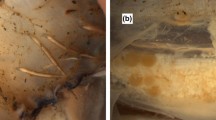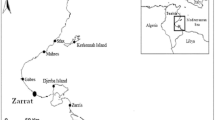Abstract
The reproductive cycles of two populations of the Recent articulate brachiopodTerebratulina retusa (Linnaeus) are described, based on samples taken between October 1985 and October 1986. Stereological analysis of the gonads revealed a single synchronised spawning event between late November and the end of January in the Firth of Lorn. In a second population, in Loch Fyne, spawning took place repeatedly throughout the spring and summer, with greatest spawning activity occurring in the late autumn.T. retusa from Loch Fyne were approximately three times more fecund than those from the Firth of Lorn. Productivity in the Clyde Sea area is approximately five times higher than in Firth of Lorn and higher fecundities and spawning frequencies of the Loch Fyne population are attributed, in part, to greater food availability. The initiation of gametogenesis appears to be mediated by the mobilisation of reserves stored in the outer mantle epithelium during the winter. Primary productivity increases dramatically in the spring and gametogenesis shows a corresponding increase.
Similar content being viewed by others
Literature cited
Atkins, D. (1959). The growth stages of the lophophore of the brachiopodsPlatida davidsoni (Eudes Deslongchamps) andP. anomioides (Philippi), with notes on the feeding mechanism. J. mar. biol. Ass. U.K. 38: 103–132
Atkins, D. (1960a). A note onDallina septigera (Loven), (Brachiopoda, Dallinidae). J. mar. biol. Ass. U.K. 39: 91–99
Atkins, D. (1960b). The ciliary feeding mechanism of the Megathyridae (Brachiopoda), and the growth stages of the lophophore. J. mar. biol. Ass. U.K. 39: 459–479
Bayne, B. L., Holland, D. L., Moore, M. N., Lowe, D. M., Widdows, J. (1978). Further studies on the effects of stress in the adult on the eggs ofMytilus edulis. J. mar. biol. Ass. U.K. 58: 825–841
Brunton, C. H. C., Curry, G. B. (1979). British brachiopods. Synopses Br. Fauna (New Ser.) 17: 1–64
Chuang, S. H. (1959). The breeding season of the brachiopodLingula unguis (L.). Biol. Bull. mar. biol. Lab., Woods Hole 117: 202–207
Chumley, J. (1918). The fauna of the Clyde Sea area. Glasgow, University Press
Collins, M. J. (1986). Taphonomic processes in a deep waterModiolus-brachiopod assemblage from the West coast of Scotland. Ph.D. thesis, University of Glasgow
Collins, M. J., Curry, G. B., Muyzer, G., Westbroek, P., Zomerdijk, T., Quinn, R. (1988). Sero-taxonomy of skeletal macromolecules in living terebratulid brachiopods. Hist. Biol. 1: 207–224
Comely, C. A., Ansell, A. D. (1988). Population density and growth ofEchinus esculentus L. on the Scottish west coast. Estuar. cstl Shelf Sci. 27: 311–334
Curry, G. B. (1982). Ecology and population structure of the Recent brachiopodTerebratulina retusa from Scotland. Palaeontology 25: 227–246
Davidson, T. (1886–1888). A monograph of recent Brachiopoda. Trans. Linn. Soc. Lond (Ser. Zool.) 4: parts I–III
Edwards, A., Sharples, F. (1985). Scottish sea lochs. Scottish Marine Biological Association, Oban, Argyll (Internal Rep. No. 134)
Freer, R. H: (1967). Stereologic techniques in microscopy. Jl R. microsc. Soc. 87: 25–34
Hammond, L. S. (1982). Breeding season, larval development and dispersal ofLingula anatina (Brachiopoda, Inarticulata) from Townsville, Australia. J. Zool., Lond. 198: 183–196
Hyman, L. H. (1959). The lophophorate coelomates — phylum Brachiopoda. In: The invertebrates. Vol. 5. Smaller coelomate groups. Chapter XXI. McGraw Hill Book Co., Inc., New York, p. 561–609
Jablonski, D., Lutz, R. A. (1983). Larval ecology of marine benthic invertebrates: paleobiological implications. Biol. Rev. 58: 21–89
James, M. A., Ansell, A. D., Curry, G. B. (1991a). Functional morphology of the gonads of the recent articulate brachiopodTerebratulina retusa. Mar. Biol. (in revision)
James, M. A., Ansell, A. D., Curry, G. B. (1991b). Oogenesis in the recent articulate brachiopodTerebratulina retusa. Mar. Biol. (in revision)
Jones, K., Cabecadas, L., Gowen, R., Robertson, N., Tett, P. (1981). The distribution of phytoplankton and nutrients in relation to the hydrography of Loch Fyne and its approaches: a report of a cruise by M. V. Arvor, 7–12 September, 1981. Scottish Marine Biological Association, Oban, Argyll (Internal Rep. No. 51)
Kume, M. (1956). The spawnings ofLingula. Nat. Sci. Rep. Ochanomizu Univ. 6: 215–223
Lee, J. B. (1985). The development and application of a stereological gonad index used to study the reproductive cycles ofChlamys islandica (O. Müller) andChlamys opercularis (L.) Bivalvia, Pectinidae. Ph.D. thesis, Heriot-Watt University, Edinburgh
Lowe, D. M., Moore, M. N., Bayne, B. L. (1982). Aspects of gametogenesis in the marine musselMytilus edulis (L.). J. mar. biol. Ass. U.K. 62: 133–145
Mackie, L. A. (1986). Aspects of the reproductive biology of the scallopPecten maximus (L.) in Scottish waters. Ph.D. thesis, Heriot-Watt University, Edinburgh
Morvan, C., Ansell, A. D. (1988). Stereological methods applied to reproductive cycle ofTapes rhomboides. Mar. Biol. 97: 355–364
Newell, R. I. E., Bayne, B. L. (1980). Seasonal changes in the physiology, reproductive condition and carbohydrate content of the cockleCardium (=Cerastoderma)edule. (Bivalvia: Cardiidae). Mar. Biol. 56: 11–19
Paine, R. T. (1963). Ecology of the brachiopodGlottidia pyramidata. Ecol. Monogr. 33: 187–213
Papanicolaou, G. N. (1942). A new procedure for staining vaginal smears. Science, N.Y. 95: 438–439
Percival, E. (1944). A contribution to the life history of the brachiopodTerebratella inconspicua Sowerby. Trans. R. Soc. N.Z. 74: 1–23
Percival, E. (1960). A contribution to the life history of the brachiopodTegulorhynchia nigricans. Q. Jl microsc. Sci. 101: 439–457
Rickwood, A. E. (1968). A contribution to the life history and biology of the brachiopodPumilus antiquatus Atkins. Trans. R. Soc. N.Z. (Zool.) 10: 163–182
Rokop, f. J. (1977). Seasonal reproduction of the brachiopodFrieleia halli and the scaphopodCadulus californicus at bathyal depths in the deep sea. Mar. Biol. 43: 237–246
Rudwick, M. J. S. (1970). Living and fossil brachiopods. Hutchinson & Co. Ltd
SAS Institute Inc. (1985). SAS user's guide: statistics. Version 5 edition. SAS Institute Inc., Cary, North Carolina
Sokal, R. R., Rohlf, F. J. (1981). Biometry. The principles and practice of statistics in biological research. 2nd ed. W. H. Freeman & Co., San Francisco
Sundet, J. H., Lee, J. B. (1984). Seasonal variations in gamete development in the Iceland scallop,Chlamys islandica. J. mar. biol. Ass. U.K. 64: 411–416
Tett, P., Gowen, R., Grantham, B., Jones, K., Millar, B. S. (1986). The phytoplankton ecology of the Firth of Clyde sea-lochs, Striven and Fyne. Proc. R. Soc. Edinb. (Sect. B) 90: 223–238
Thayer, C. W. (1975). Size frequency and population structure of brachiopods. Palaeogeogr. Palaeoclim. Palaeoecol. 17: 139–148
Webb, G. R., Logan, A., Noble, J. P. A. (1976). Occurrence and significance of brooded larvae in a recent brachiopod, Bay of Fundy, Canada. J. Paleontol. 50: 869–871
Weibel, E. R. (1979). Stereological methods. Vol. 1. Practical methods for biological morphometry. Academic Press, New York
Weibel, E. R., Kistler, G. S., Scherle, W. F. (1966). Practical stereological methods for morphometric cytology. J. Cell Biol. 30: 23–38
Williams, A., Rowell, A. J. (1965) (H) Brachiopoda. Parts 1–2. In: Moore, R. C. (ed.) Treatise on invertebrate paleontology. Geological Society of America Inc., and University of Kansas Press, New York, p. 1–927
Yankson, K. (1983). Studies on the reproductive biology of two species ofCerastoderma (Lamellibranchia). Ph.D. thesis, University College, Swansea
Yatsu, N. (1902). Notes on the histology ofLingula anatina Bruguière. J. Coll. Sci. imp. Univ. Tokyo 17: 1–29
Author information
Authors and Affiliations
Additional information
Communicated by J. Mauchline, Oban
Rights and permissions
About this article
Cite this article
James, M.A., Ansell, A.D. & Curry, G.B. Reproductive cycle of the brachiopodTerebratulina retusa on the west coast of Scotland. Mar. Biol. 109, 441–451 (1991). https://doi.org/10.1007/BF01313509
Accepted:
Issue Date:
DOI: https://doi.org/10.1007/BF01313509




